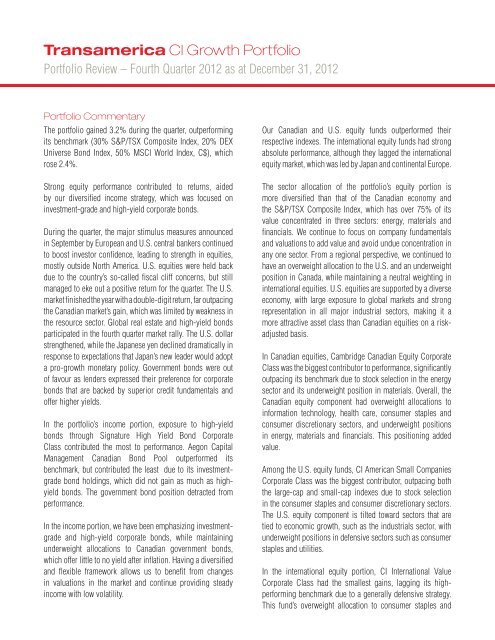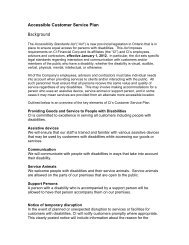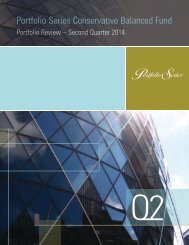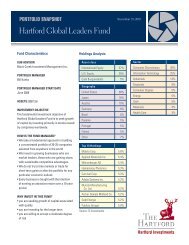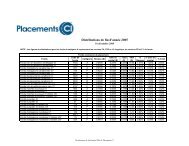Transamerica CI Growth Portfolio - CI Investments
Transamerica CI Growth Portfolio - CI Investments
Transamerica CI Growth Portfolio - CI Investments
- No tags were found...
You also want an ePaper? Increase the reach of your titles
YUMPU automatically turns print PDFs into web optimized ePapers that Google loves.
<strong>Transamerica</strong> <strong>CI</strong> <strong>Growth</strong> <strong>Portfolio</strong><strong>Portfolio</strong> Review – Fourth Quarter 2012 as at December 31, 2012<strong>Portfolio</strong> CommentaryThe portfolio gained 3.2% during the quarter, outperformingits benchmark (30% S&P/TSX Composite Index, 20% DEXUniverse Bond Index, 50% MS<strong>CI</strong> World Index, C$), whichrose 2.4%.Strong equity performance contributed to returns, aidedby our diversified income strategy, which was focused oninvestment-grade and high-yield corporate bonds.During the quarter, the major stimulus measures announcedin September by European and U.S. central bankers continuedto boost investor confidence, leading to strength in equities,mostly outside North America. U.S. equities were held backdue to the country’s so-called fiscal cliff concerns, but stillmanaged to eke out a positive return for the quarter. The U.S.market finished the year with a double-digit return, far outpacingthe Canadian market’s gain, which was limited by weakness inthe resource sector. Global real estate and high-yield bondsparticipated in the fourth quarter market rally. The U.S. dollarstrengthened, while the Japanese yen declined dramatically inresponse to expectations that Japan’s new leader would adopta pro-growth monetary policy. Government bonds were outof favour as lenders expressed their preference for corporatebonds that are backed by superior credit fundamentals andoffer higher yields.In the portfolio’s income portion, exposure to high-yieldbonds through Signature High Yield Bond CorporateClass contributed the most to performance. Aegon CapitalManagement Canadian Bond Pool outperformed itsbenchmark, but contributed the least due to its investmentgradebond holdings, which did not gain as much as highyieldbonds. The government bond position detracted fromperformance.In the income portion, we have been emphasizing investmentgradeand high-yield corporate bonds, while maintainingunderweight allocations to Canadian government bonds,which offer little to no yield after inflation. Having a diversifiedand flexible framework allows us to benefit from changesin valuations in the market and continue providing steadyincome with low volatility.Our Canadian and U.S. equity funds outperformed theirrespective indexes. The international equity funds had strongabsolute performance, although they lagged the internationalequity market, which was led by Japan and continental Europe.The sector allocation of the portfolio’s equity portion ismore diversified than that of the Canadian economy andthe S&P/TSX Composite Index, which has over 75% of itsvalue concentrated in three sectors: energy, materials andfinancials. We continue to focus on company fundamentalsand valuations to add value and avoid undue concentration inany one sector. From a regional perspective, we continued tohave an overweight allocation to the U.S. and an underweightposition in Canada, while maintaining a neutral weighting ininternational equities. U.S. equities are supported by a diverseeconomy, with large exposure to global markets and strongrepresentation in all major industrial sectors, making it amore attractive asset class than Canadian equities on a riskadjustedbasis.In Canadian equities, Cambridge Canadian Equity CorporateClass was the biggest contributor to performance, significantlyoutpacing its benchmark due to stock selection in the energysector and its underweight position in materials. Overall, theCanadian equity component had overweight allocations toinformation technology, health care, consumer staples andconsumer discretionary sectors, and underweight positionsin energy, materials and financials. This positioning addedvalue.Among the U.S. equity funds, <strong>CI</strong> American Small CompaniesCorporate Class was the biggest contributor, outpacing boththe large-cap and small-cap indexes due to stock selectionin the consumer staples and consumer discretionary sectors.The U.S. equity component is tilted toward sectors that aretied to economic growth, such as the industrials sector, withunderweight positions in defensive sectors such as consumerstaples and utilities.In the international equity portion, <strong>CI</strong> International ValueCorporate Class had the smallest gains, lagging its highperformingbenchmark due to a generally defensive strategy.This fund’s overweight allocation to consumer staples and


